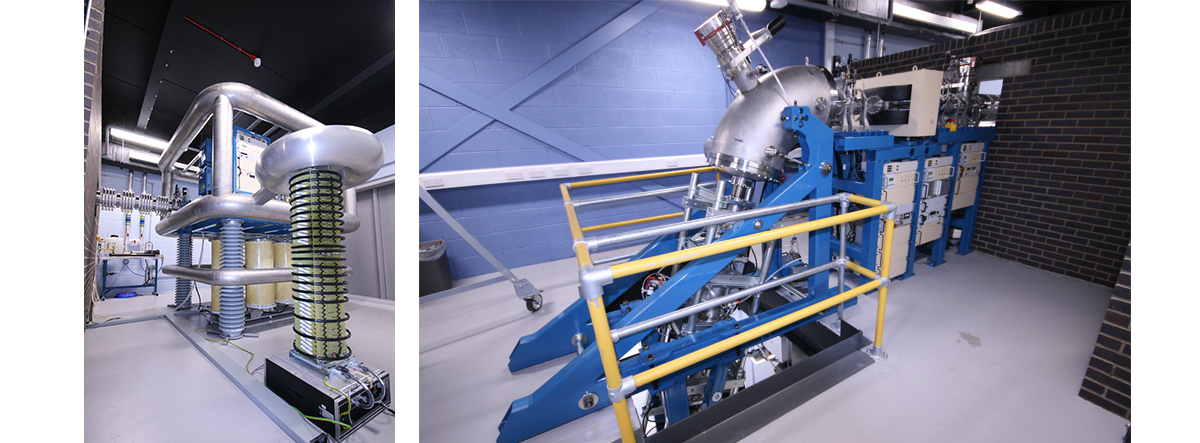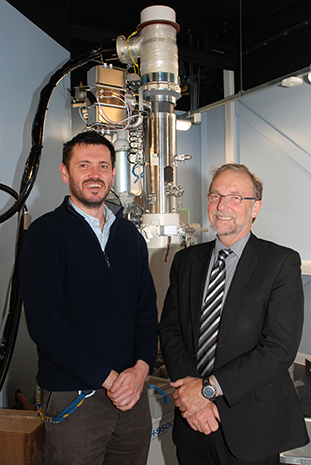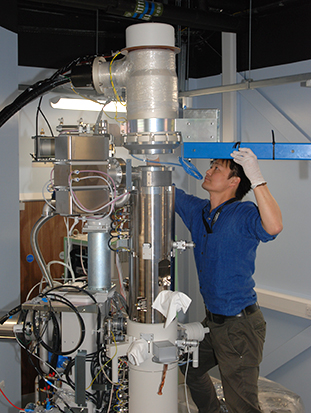New £3.5m microscope and ion accelerator now operational

Mon, 22 May 2017 12:29:00 BST
The Microscope and Ion Accelerator for Materials Investigations, or MIAMI-2, is already being used for experiments
 ◄Dr Jonathan Hinks and Professor Steve Donnelly
◄Dr Jonathan Hinks and Professor Steve Donnelly
THE completion of a £3.5 million research facility means that the University of Huddersfield is established as one of Europe’s leading centres for the use of ion beams as a tool for the investigation of issues ranging from nuclear technology and nanoparticles to semiconductors and the effects of radiation exposure on materials in space.
Europe has three transmission electron microscopes with in situ ion beam research facilities and two of them are in Huddersfield. First came MIAMI – standing for Microscope and Ion Accelerator for Materials Investigations. It was designed and built by Professor Steve Donnelly, the University’s Dean of Computing and Engineering, Professor Jaap van den Berg (pictured below right) of the International Institute for Accelerator Applications and Dr Jonathan Hinks, a Reader in Radiation Damage in Materials at the University.
 Now referred to as MIAMI-1, the original facility was a bespoke combination of ion accelerator with an electron microscope, enabling nanoscale investigation of radiation damage, and is still a valuable research tool. But it has now been joined by the more powerful, versatile and much larger MIAMI-2, which has dual ion beams and greatly enhanced analytical capabilities.
Now referred to as MIAMI-1, the original facility was a bespoke combination of ion accelerator with an electron microscope, enabling nanoscale investigation of radiation damage, and is still a valuable research tool. But it has now been joined by the more powerful, versatile and much larger MIAMI-2, which has dual ion beams and greatly enhanced analytical capabilities.
The Engineering and Physical Sciences Research Council (EPSRC) awarded £3.5 million for the development and construction of MIAMI-2, which has required the construction of a new storey at the laboratory complex in which it is housed.
Designed and constructed in collaboration with major companies such as Bruker, Hitachi, Gatan and National Electrostatics Corporation – all of which have contributed major components – MIAMI-2 will have an official launch later in the year, but it is already operational and being used for experiments, said Dr Hinks.
“For example, we were working with some Belgian colleagues only last week who are looking at novel materials they have developed for next-generation nuclear reactors.”
 ◄A Hitachi engineer assembling the MIAMI-2 microscope
◄A Hitachi engineer assembling the MIAMI-2 microscope
Demand is already high to use MIAMI-2, and will increase even further now that the University of Huddersfield has become one of the three UK universities to form the UK National Ion Beam Centre (UKNIBC), funded to the tune of £8.8 million – again by EPSRC.
The MIAMI-2 team of six members of academic staff plus four PhD researchers – expected to rise to seven by the close of the year – and is now well on the learning curve of mastering the complex new facility and its exceptional potential. It will bring major advantages, enabling the use of single or dual ion beams to carry out in situ irradiation of samples in its Hitachi electron microscope.
“With MIAMI-1, we have always had the core ability to observe radiation damage as it is happening, but now we have additional capabilities in terms of the analytical techniques. We can irradiate, observe and analyse all at the same time generating a huge volume of invaluable scientific data in a very efficient manner” said Dr Hinks.
Although external scientists will make extensive use of MIAMI-2, the University of Huddersfield’s own researchers will also take full advantage of the facility.
“Currently, our largest area of activity is nuclear materials, with large projects and international collaborations on both structural materials for reactors and solutions for waste storage. However, our group has historically worked with semiconductors, and among the range of projects in which we are currently engaged we have two PhD students working on nanowires and other types of nanoparticles,” said Dr Hinks.
“We also have an interest in materials that have been in space or which are going into space, to understand the radiation they experience, and also develop a greater understanding of the history of the cosmos.”







